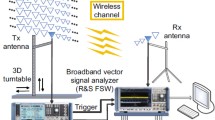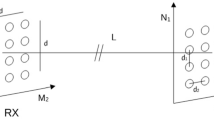Abstract
A study of a Multiple-Input Multiple-Output (MIMO) system in a street corner is presented in order to analyze the keyhole effect. First, MIMO channel matrices are calculated in this environment by using a ray launching model to theoretically analyze the problem. In this sense, results show that, in a Non-Line-of-Sight (NLoS) situation, capacity is close to the keyhole limit, since only diffracted rays are received. Moreover, measurements carried out in a similar environment are also presented, and results are compared with the theoretical results. The keyhole effect was difficult to measure in the real environment, since many other contributions were received. However, in the NLoS positions, and by analyzing only the diffracted contribution, a nearly keyhole capacity is found.












Similar content being viewed by others
References
Foschini, G. J., & Gans, J. (1998). On limits of wireless communications in a fading environment when using multiple antennas. Wireless Personal Communications, 6(3), 311–335.
Telatar, I. E. (1995). Capacity of multi-antenna Gaussian channel. Memo: AT&T Bell Labs Tech.
Hanzo, L. L., Akhtman, Y., Wang, L., & Jiang, M. (2011). MIMO-OFDM for LTE, WiFi and WiMAX: Coherent versus non-coherent and cooperative turbo transceivers. Chichester (UK): Wiley-IEEE Press.
Shiu, D., Foschini, G. J., Gans, M. J., & Kahn, J. M. (2000). Fading correlation and its effect on the capacity of multielement antenna systems. IEEE Transactions on Communications, 48(3), 502–513.
Svantesson, T., & Wallace, J. (2003). On signal strength and multipath richness in multi-input multi-output systems. In IEEE international conference on communications ICC ‘03 (Vol. 4, pp. 2683–2687).
Molisch, A. F. (2011). Wireless communications. Chichester, UK: Wiley-IEEE Press.
Chizhik, D., Foschini, G. J., Gans, M. J., & Valenzuela, R. A. (2002). Keyholes, correlations, and capacities of multielement transmit and receive antennas. IEEE Transactions on Wireless Communications, 1(2), 361–368.
Ling, J., Chizhik, D., & Valenzuela, R. A. (2001). Predicting multi-element receive and transmit array capacity outdoors with ray tracing. In IEEE proceedings of vehicular technology conference (Vol. 1, pp. 392–394).
Almers, P., Tufvesson, F., & Molisch, A. F. (2006). Keyhole effect in MIMO wireless channels: Measurements and theory. IEEE Transactions on Wireless Communications, 5(12), 3596–3604.
Zhong, C., Jin, S., Wong, K.-K., & McKay, M. R. (2009). Performance analysis of optimal joint beamforming in multi-keyhole MIMO channels. In IEEE international conference on communications.
Hong Zhi, Z., Youxi, T., & Gong, Y. (2009). Effect of correlations on the symbol error rate of orthogonal space-time block codes in keyhole MIMO channels. In International conference on communications, circuits and systems.
Zhao, H., Gong, Y., Guan, Y. L., & Tang, Y. (2009). Performance analysis of M-PSK/M-QAM modulated orthogonal space–time block codes in keyhole channels. IEEE Transactions on Vehicular Technology, 58(2), 1036–1043.
Almers, P., Tufvesson, F., Karlsson, P., & Molisch, A. F. (2003). The effect of horizontal array orientation on MIMO channel capacity. In IEEE proceedings of vehicular technology conference (Vol. 1, pp. 34–38).
Kouyoumjian, R. G., & Pathak, P. H. (1974). A uniform geometrical theory of diffraction for an edge in a perfectly conducting surface. Proceedings of IEEE, 62(11), 1448–1461.
Balanis, C. A. (1989). Advanced engineering electromagnetics. New York: Wiley.
Rappaport, T. S. (1996). Wireless communications: Principles and practice. Englewood Cliffs, New Jersey: Prentice-Hall.
Loyka, S., & Kouki, A. (2002). On MIMO channel capacity, correlations, and keyholes: Analysis of degenerate channels. IEEE Transaction on Communications, 50(12), 1886–1888.
Molisch, A. F., Steinbauer, M., Toeltsch, M., Bonek, E., & Thomä, R. S. (2002). Capacity of MIMO systems based on measured wireless channels. IEEE Journal on Selected Areas in Communications, 20(3), 561–569.
Tang, Z., & Mohan, A. S. (2005). Characterize the indoor multipath propagation for MIMO communications. In Asia-Pacific conference proceedings (APMC) (Vol. 4).
Acknowledgments
This work was supported by the Ministerio de Economía y Competitividad (MINECO), Spain (TEC2013-47360-C3-2) and by the European FEDER funds.
Author information
Authors and Affiliations
Corresponding author
Rights and permissions
About this article
Cite this article
Pascual-García, J., Rodríguez, JV., Molina-García-Pardo, JM. et al. Theoretical and Experimental Analysis of the Keyhole Effect for a Multi-antenna System in a Street Corner Environment at 2.4 GHz. Wireless Pers Commun 83, 2561–2578 (2015). https://doi.org/10.1007/s11277-015-2555-3
Published:
Issue Date:
DOI: https://doi.org/10.1007/s11277-015-2555-3




